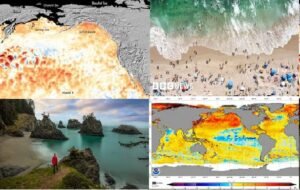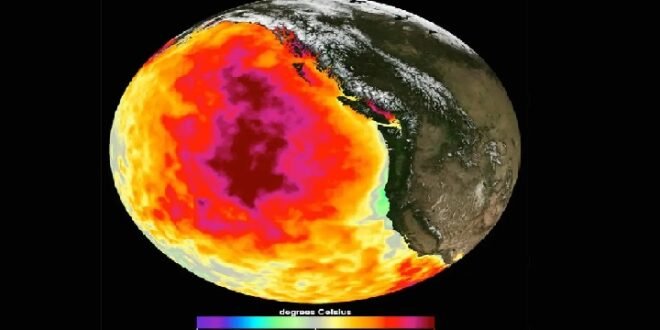19-10-2025
LONDON: The waters of the north Pacific have had their warmest summer on record, according to media analysis of a mysterious marine heatwave that has confounded climate scientists.
 Sea surface temperatures between July and September were more than 0.25C above the previous high of 2022, a big increase across an area roughly ten times the size of the Mediterranean.
Sea surface temperatures between July and September were more than 0.25C above the previous high of 2022, a big increase across an area roughly ten times the size of the Mediterranean.
While climate change is known to make marine heatwaves more likely, scientists are struggling to explain why the north Pacific has been so hot for so long but all this extra heat in the so-called “warm blob” may have the opposite effect in the UK, possibly making a colder start to winter more likely, some researchers believe.
“There’s definitely something unusual going on in the north Pacific,” said Zeke Hausfather, a climate scientist at Berkeley Earth, a research group in the US.
Such a jump in temperatures across a region so large is “quite remarkable”, he added. Media analyzed data from the European Copernicus climate service to calculate average temperatures between July and September across a large area of the north Pacific, sometimes known as the “warm blob”.
The region extends from the east coast of Asia to the west coast of North America, the same area used in previous scientific studies.
The figures show that not only has the region been warming quickly over the past couple of decades, but 2025 is markedly higher than recent years too.
Line graph showing average sea surface temperatures across the north Pacific between July and September, each year since 1940. There is lots of variability from year to year, but temperatures have generally been going up this century. Temperatures this year are far above any previously recorded level.
That the seas are getting hotter is no surprise. Global warming, caused by humanity’s emissions of carbon dioxide and other gases, has already trebled the number of days of extreme heat in oceans globally, according to research published earlier this year but temperatures have been even higher than most climate models, computer simulations taking into account humanity’s carbon emissions, had predicted.
 Analysis of these models by the Berkeley Earth group suggests that sea temperatures observed across the north Pacific in August had less than a 1% chance of occurring in any single year.
Analysis of these models by the Berkeley Earth group suggests that sea temperatures observed across the north Pacific in August had less than a 1% chance of occurring in any single year.
Natural weather variability is thought to be part of the reason. This summer has seen weaker-than-usual winds, for example. That means more heat from the summer sunshine can stay in the sea surface, rather than being mixed with cooler waters below but this can only go so far in explaining the exceptional conditions, according to Dr Hausfather.
“It certainly is not just natural variability,” he said. “There’s something else going on here as well.”
Three maps showing sea surface temperatures in July, August and September in the north Pacific, which is marked by a box. Temperatures are unusually warm across almost the entire region in each month, marked by oranges and dark reds.
One intriguing idea is that a recent change to shipping fuels might be contributing to the warming. Prior to 2020, dirty engine oil produced large amounts of sulphur dioxide, a gas harmful to human health but that sulphur also formed tiny, Sun-reflecting particles in the atmosphere, known as aerosols, which helped to keep a lid on rising temperatures.
So removing that cooling effect in shipping hotspots like the north Pacific could be revealing the full impact of human-caused warming. (Int’l News Desk)
 Pressmediaofindia
Pressmediaofindia




